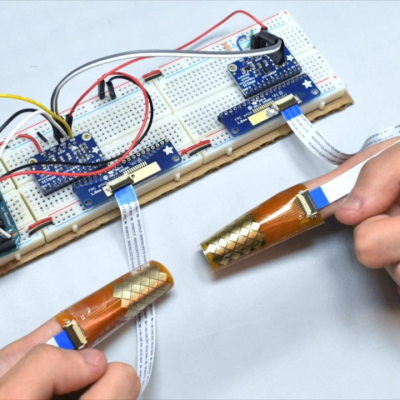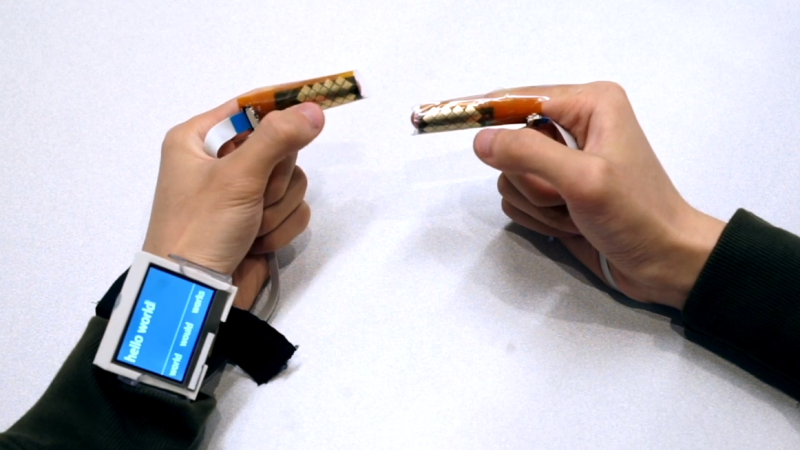
Touch-typing with thumbs on a mobile phone keyboard is a pretty familiar way to input text, and that is part of what led to BiTipText, a method of allowing bimanual text input using fingertips. The idea is to treat the first segments of the index fingers as halves of a tiny keyboard, whose small imaginary keys are tapped with the thumbs. The prototype shown here was created to see how well the concept could work.
The prototype hardware uses touch sensors that can detect tap position with a high degree of accuracy, but the software side is where the real magic happens. Instead of hardcoding a QWERTY layout and training people to use it, the team instead ran tests to understand users’ natural expectations of which keys should be on which finger, and how exactly they should be laid out. This data led to an optimized layout, and when combined with predictive features, test participants could achieve an average text entry speed of 23.4 words per minute.
Judging by the prototype hardware, it’s understandable if one thinks the idea of fingertip keyboards may be a bit ahead of its time. But considering the increasingly “always on, always with you” nature of personal technology, the goal of the project was more about investigating ways for users to provide input in fast and subtle ways. It seems that the idea has some merit in principle. The project’s paper can be viewed online, and the video demonstration is embedded below.
One interesting thing is this: the inertia of users being familiar with a QWERTY layout is apparent even in a forward-thinking project like this one. We covered how Dvorak himself struggled with people’s unwillingness to change, even when there were clear benefits to doing so.
[via Arduino Blog]
















“Touch-typing with thumbs on a mobile phone keyboard is a pretty familiar way to input text”. You must mean crappy and inefficient. Hope they get the next common interface right.
How else do you use a phone keyboard?
Penguin in ice cave: “Slide!”
MessagEase
Simple, I use the buttons on my 3720. That is a functional (mobile) phone. I have practical computers for the tasks that require me to type longer texts.
Q: How do you use a phone keyboard?
A: unhappily
This is neat but it seems to go in the other direction from what I need. The frustrating thing about touch screen input is that you don’t know which key you hit until it shows up on the screen. You may not have to look at the keyboard, but you still have to retain a closed-loop control path at every moment. Real clicky keyboards allow reasonable success with open-loop control. I can actually detect most typos by feel alone. I use backspace a good amount even when my eyes are closed.
I keep hoping that something like the Twiddler takes off for smartphones in an affordable and portable form, but I’m not sure how that could really happen. Twiddler’s $200 price point is certainly a strong deterrent. In the meantime I use a bluetooth regular keyboard…it doesn’t fit in my pocket but doesn’t take much space in my backpack.
I am reminded of Sid Owen’s (later my boss,) 1-handed hemispherical kybd… made cover of Popular Sci or Elec… for buzy execs who drove their own Rolls and hated dicto machines. It did take 4 fingers, but that relieves one hand. Idid texting fine w flip-phs w/o looking. HATE bar phs!
Haha I’m not sure anybody is going to want to take typing advice from this kind of message.
Just braining out loud, but I wonder if one could solder mini push switches in an array like those LED glasses recently posted, only in a half tube configuration.
Though by the way, if this is for a wearable, on the go computer, I’d think I’d want them on my middle fingers rather than index.
Bill Smythe- Are you referring to the “Write Hander” that was once featured on the cover of a popular computer magazine in the ’70’s or early ’80’s? (I can’t remember if I first saw it on Byte, Compute, or some other mag.) Over the years I have seen a number of “one-handed-mouse-input devices that use somewhat similar methods. I always thought that a device with emg sensors and a biofeedback conditioning system would allow a person to input text and vectors at an incredibly fast rate.